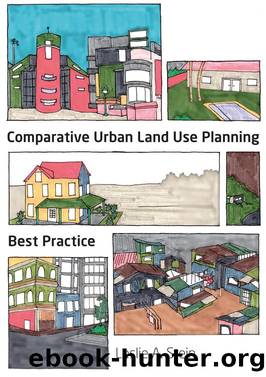Comparative Urban Land Use Planning by Stein Leslie A.;Dixon Robert;Holgate Ben;

Author:Stein, Leslie A.;Dixon, Robert;Holgate, Ben; [Les Stein]
Language: eng
Format: epub
ISBN: 5574421
Publisher: Sydney University Press
Published: 2017-08-15T00:00:00+00:00
These controls are contained in a formal legal instrument: a by-law, ordinance, or some regulatory document that enforces the manner in which land uses can occur in different zones. The legal instrument makes reference to the zoning map that is either included in the document or referenced. In larger cities, the maps are plentiful and are incorporated by reference.
The source of the designation of a zone and its rightful place in the spatial plan is based on an assessment of the nature and character of the area as it is and will be. It therefore draws its legitimacy as an expression of the strategic plan even in the absence of a narrative explaining its purpose or the fact that it does not have a direct concordance with the goals and aspirations. The decision to zone an area is not perceived as random and is understood as being influenced by significant, measurable factors such as population forecasts and transport routes. Existing transportation routes are often a key factor in establishing credibility for the choice of zones, as shown in a study for Spain where the location of highways was the major reason for rezoning land for urban, rather than rural use.8
Land use designations for a zone do not need to be achieved only by a generalised view of the character of an area, its potential, or the placement of transportation routes. Mathematical models have been developed that attempt to refine the decision about the appropriate zoning and take into account population forecasting, patterns or vectors of existing development, and ecological issues. The ecological issues, as found in a study of northern China, have a high priority in the operation of these models, as these issues have a particular intensity due to the nature of the multiple environmental variables addressed in the equations and ensuing interrelationships.9
There are policy choices that must be made in respect of conflicting interests that are not reflected in models, such as the effect of a decision to allow zoning for retail shopping in one area on the existing shops in a nearby area. These land use conflicts are resolved by historical rules, such as that competition should not be a relevant land use consideration, or that there should be different forms of shopping (large retail centres as well as llocal shops) in proximity to every resident.
As a matter of practice, the choice of forms for residential zoning is not derived from mathematical modelling but is influenced by a subjective assessment of the character of the area and the unarticulated goal of residential exclusiveness. The assessment that relies on the character of the area and includes exclusivity is also the basis for development standards for that zone. In this sense, the zoning is self-selecting for residential areas as it is congruent with the operation of the land market where the factors of character and exclusivity are critical to land transactions.
In Houston, Texas, there is no zoning code and therefore there is a greater reliance on an intelligent market, deed restrictions, and the common law of nuisance.
Download
This site does not store any files on its server. We only index and link to content provided by other sites. Please contact the content providers to delete copyright contents if any and email us, we'll remove relevant links or contents immediately.
International Integration of the Brazilian Economy by Elias C. Grivoyannis(79194)
The Radium Girls by Kate Moore(11658)
Turbulence by E. J. Noyes(7741)
Nudge - Improving Decisions about Health, Wealth, and Happiness by Thaler Sunstein(7282)
The Black Swan by Nassim Nicholas Taleb(6801)
Rich Dad Poor Dad by Robert T. Kiyosaki(6221)
Pioneering Portfolio Management by David F. Swensen(6099)
Man-made Catastrophes and Risk Information Concealment by Dmitry Chernov & Didier Sornette(5691)
Zero to One by Peter Thiel(5523)
Secrecy World by Jake Bernstein(4427)
Millionaire: The Philanderer, Gambler, and Duelist Who Invented Modern Finance by Janet Gleeson(4134)
The Age of Surveillance Capitalism by Shoshana Zuboff(4015)
Skin in the Game by Nassim Nicholas Taleb(4000)
The Money Culture by Michael Lewis(3877)
Bullshit Jobs by David Graeber(3866)
Skin in the Game: Hidden Asymmetries in Daily Life by Nassim Nicholas Taleb(3750)
The Dhandho Investor by Mohnish Pabrai(3583)
The Wisdom of Finance by Mihir Desai(3545)
Blockchain Basics by Daniel Drescher(3350)
